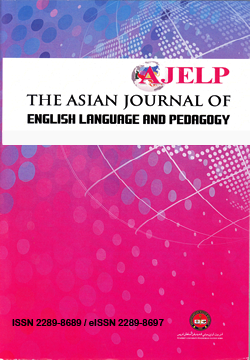Examining the Reading Anxiety Phenomenon of Arab EFL learners
DOI:
https://doi.org/10.37134/ajelp.vol9.1.3.2021Keywords:
Foreign Language Anxiety, Reading Anxiety, Arab EFL Learners, Reading Anxiety Factors, CorrelationAbstract
The anxiety phenomenon has been widely acknowledged as one of the most important psychological phenomena. Theorists and second language researchers claimed that anxiety and language learning are associated. Thus learners who portray low levels of anxiety allow more and better input into the brain, increasing their language learning performance. However this may not be the case for many learners of English as a foreign language (EFL). They face challenges of learning new vocabulary, grammar, pronunciation and reading in the target language. In reading, most of the texts require critical synthesis, evaluation and interpretation to comprehend the authors’ point of views. These reading experiences may increase students’ levels of anxiety if they are unprepared for such demands. As a result, learners become tense and continue to experience high levels of anxiety as they suffer from poor performance in their studies. The objective of this paper is to examine the reading anxiety phenomenon experienced by a group of Arab students in their learning of English as a foreign language (EFL). Data was collected from 34 postgraduate Arab EFL students using the FLRAS (Foreign Language Reading Anxiety Scale) and focus group interviews. Data was analysed using descriptive statistics and tabulated in the form of mean frequency to answer the research questions posed. Findings revealed that cultural content, vocabulary, grammar, topic and lack of self-confidence were factors that impact students’ reading anxiety. The paper concludes with a discussion on the implications and suggestions for teaching reading within an EFL context.
Downloads
References
Ajideh, P. (2003). Schema theory-based pre-reading tasks: A neglected essential in the ESL reading class. The reading matrix, 3(1).
Al-Sawalha, A., M. . (2016). Qualitative and Quantitative Study on Listening Anxiety of Jordanian Students Majoring in English Language at Jerash University. International Journal of Humanities and Social Science, 6(1).
Al-Shboul, M. M., Ahmad, I. S., Nordin, M. S., & Rahman, Z. A. (2013). Foreign language reading anxiety in a Jordanian EFL context: A qualitative study. English Language Teaching, 6(6), 38.
Andrade, M., & Williams, K. (2009). Foreign language learning anxiety in Japanese EFL university classes: Physical, emotional, expressive, and verbal reactions. Sophia Junior College Faculty Journal, 29(1), 1-24.
Batiha, J. M., Mohd Noor, N., & Mustaffa, R. (2014). Exploring the Factors of Classroom Anxiety in the Context of EFL Arab Students. International Journal of Social Science and Humanities Research, 2 (2), 18-31.
Batiha, J. M., Mustaffa, R. M., & Noor, N. M. (2018). Foreign Language Speaking Anxiety of Jordanian Freshman English Learners (Kebimbangan Bertutur dalam Bahasa Asing oleh Pelajar Bahasa Inggeris Tahun Pertama Jordan). Akademika, 88(1).
Batiha, J. M., Noor, N. M., & Mustaffa, R. (2016). Speaking Anxiety among English as a Foreign Language Learner in Jordan: Quantitative Research. 4(10), 63-82.
Brantmeier, C. (2005). Anxiety about L2 reading or L2 reading tasks? A study with advanced language learners. reading, 5(2), 67-85.
Cutrone, P. (2009). Overcoming Japanese EFL learners' fear of speaking. Language Studies Working Papers, 1, 55-63.
Hago, O., & Khan, W. (2015). The pronunciation problems faced by Saudi EFL learners at secondary schools. Education and Linguistics Research, 1(2), 85-99.
Hair, J., Black, W., Babin, B., & Anderson, R. (2010). Multivariate Data Analysis Seventh Edition Prentice Hall.
Horwitz, E. (2001). Language anxiety and achievement. Annual review of applied linguistics, 21, 112-126.
Horwitz, E. K., Horwitz, M. B., & Cope, J. (1986). Foreign language classroom anxiety. The modern language journal, 70(2), 125-132.
Jalongo, M. R., & Hirsh, R. A. (2010). Understanding reading anxiety: New insights from neuroscience. Early Childhood Education Journal, 37(6), 431-435.
Kuru-Gonen, I. (2005). The sources of foreign language reading anxiety of students in a Turkish EFL context. reading, 11(12), 13.
Kuru-Gonen, I. (2007). L2 reading anxiety: Exploring the phenomenon. JALT2006 KITAKYUSHU Community, Identity, Motivation. Tokyo: JALT.
Li, X.-h., Wu, J., & Wang, W.-h. (2007). Analysis of schema theory and its influence on reading. US-China Foreign Language, 5(11), 18-21.
MacIntyre, P. D. (1995a). How does anxiety affect second language learning? A reply to Sparks and Ganschow. The modern language journal, 79(1), 90-99.
Matsuda, S., & Gobel, P. (2004). Anxiety and predictors of performance in the foreign language classroom. System, 32(1), 21-36.
Mikulecky, B. S. (2008). Teaching reading in a second language. Recuperado de http://longmanhomeusa.com.
Na, Z. (2007). A study of high school students’ English learning anxiety. The Asian EFL Journal, 9(3), 22-34.
Onwuegbuzie, A. J., Bailey, P., & Daley, C. E. (1999). Factors associated with foreign language anxiety. Applied Psycholinguistics, 20(02), 217-239.
Rachman, S. (2004). Fear of contamination. Behaviour research and therapy, 42(11), 1227-1255.
Saito, Y., Garza, T. J., & Horwitz, E. K. (1999). Foreign language reading anxiety. The modern language journal, 83(2), 202-218.
Sas, M. M. (2002). Reading Anxiety's Effects on Incidental Vocabulary Acquisitions: are Culturally Relevant Texts Exempt?
Sellers, V. D. (2000). Anxiety and reading comprehension in Spanish as a foreign language. Foreign Language Annals, 33(5), 512-520.
Sila, A. (2010). Young adolescent students’ foreign language anxiety in relation to language skills at different levels. The Journal of International Social Research, 3(11), 83-91.
Sparks, R. L., & Ganschow, L. (1991). Foreign language learning differences: Affective or native language aptitude differences? The modern language journal, 75(1), 3-16.
Wu, K.-h. (2010). The relationship between language learners' anxiety and learning strategy in the CLT classrooms. International Education Studies, 3(1), 174.
Zbornik, J. (2001). Make sure your math anxiety diagnosis, remediation add up. Today’s School Psychologist, 5(5), 3-8.
Zheng, Y. (2008). Anxiety and second/foreign language learning revisited. CJNSE/RCJCÉ, 1(1), 1-12.
Zikmund, W., Babin, B., Carr, J., & Griffin, M. (2012). Business Research Methods: Cengage Learning. H4 B.





